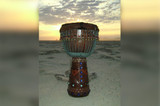How to Repair Bongos Drum Heads
A broken, cracked or torn drum head can make a drum impossible to play. Stresses like traveling, storage or exposure to harsh weather conditions can cause a natural skin drum head to split or break. Bongos, one of the most portable drums available, can be subjected to these changes throughout the life of the drums, and repairing the natural skin of the drum head is a challenging undertaking for even the most experienced bongocero.
In order to keep the tone and sound consistent between the macho and hembra drums that make up the bongos, it is recommended that both drum heads are repaired or replaced at the same time, especially if the skins are older. To begin repairing the drum head, the first step is to remove the old skin. Loosen the lugs that hold the rim in place, noting any resistance when unscrewing the hardware. Once the hardware is removed, lift the drum head gently, keeping the rim intact. Remove the old drum head by soaking it in water until the rim and/or hoop comes away from the skin easily. Repeat with the other drum, preparing to re-skin the bongo drums with new animal hide that has been soaking in water.
After soaking, the new hide should be soft and pliable and can be centered over the top of the drum. Gently press the hoop over the new hide, holding it in place against the drum and keeping the folds evenly spaced around the drum. Pull the excess skin up and around the hoop, covering the hoop. Then secure the skin by replacing the rim of the bongo drum over the skin and hoop. Tighten the hardware that holds the rim to the drum, being sure to tighten it evenly around the drum. Check to be sure the rim is evenly spaced around the skin and level with the top of the drum. Finally, using a utility or other sharp blade, trim away the excess skin, flush with the rim. Let the drum dry for 24 hours before playing.
Repairing a damaged skin on a set of bongo drums can be easily accomplished in a few hours. The results are a long-lasting appreciation of the instrument itself and the work that goes into the construction, as well as a new surface to play and better sound. By keeping your bongos heads in the best shape possible, they will last for years to come.
Recent Posts
-
What is the Best Size Djembe for Beginners?
If you're new to the world of percussion and interested in learning the djembe, you're in for a t …16th Jul 2024 -
The Benefits of Becoming a Drumming Teacher: Transforming Passion into Profession
Why become a drumming teacher? Becoming a drumming teacher is an excellent way to share your pas …22nd May 2024 -
What Makes the Djembe Drum a Spiritual Instrument in African Music?
Origin and history of the Djembe drum The Djembe drum originates from West Africa and holds sign …16th May 2024



